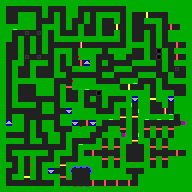
The game culminates in a final showdown with the evil vampire himself. The party's travels take them to three cities (Specularum, Radlebb Keep, and Kelvin) as well as to various ruined sites, keeps, caves, and forests as they attempt to recover the four stones (ruby, onyx, death gem, and diamond) and prevent the evil Vampire Koriszegy from amassing an army of the dead. Shortly thereafter the party uncovers assassination plots against Karameikan leaders, a conspiracy between various factions to turn innocent people into undead, and foretellings of the return of an ancient vampire. Lord Korrigan, the ruler of Radlebb Keep, commissions the party of adventurers to investigate strange rumors of vampires, lycanthropes, and undead roaming the lands. The Staff of Halav is the only item that can kill the Vampire Koriszegy. The Chalice is able to neutralize the poison that nearly kills Duke Stefan. The Staff of Life allows access into Koriszegy Crypt. The Four Stones (ruby, onyx, death gem, and diamond) imbue the user with the ability to transform living victims into the undead. The game also includes a number of powerful magic items. Order of the Griffon uses a first-person perspective similar to Eye of the Beholder in cities and dungeons, and a bird's eye view for both the overland map and combat encounters. Characters start at the 1st level of experience and can achieve a maximum of 8th level. Although characters are pre-generated, the player is offered three character options per class, each with different strengths and weaknesses. Players select four pre-generated characters from the following classes: fighter, dwarf, mage, thief, halfling, cleric, and elf.

Unlike many Gold Box games, however, Order of the Griffon utilizes the Basic Dungeons & Dragons rules instead of the AD&D rules.

Order of the Griffon uses a turn-based combat engine similar to that of the Gold Box games, such as Pool of Radiance. The game is set in the nation of Karameikos within D&D 's Mystara setting.

Order of the Griffon is a tactical role-playing game for the TurboGrafx-16 developed by Westwood Associates and based on the tabletop role-playing game Dungeons & Dragons ( D&D).


 0 kommentar(er)
0 kommentar(er)
